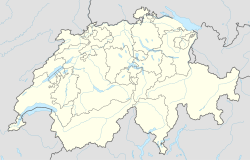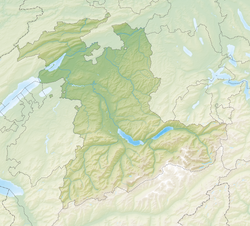Horrenbach-Buchen
| Horrenbach-Buchen | ||
|---|---|---|
|
||
| Coordinates: 46°46′N 7°45′E / 46.767°N 7.750°ECoordinates: 46°46′N 7°45′E / 46.767°N 7.750°E | ||
| Country | Switzerland | |
| Canton | Bern | |
| District | Thun | |
| Government | ||
| • Mayor | Wilhelm Balmer | |
| Area | ||
| • Total | 20.44 km2 (7.89 sq mi) | |
| Elevation | 1,000 m (3,000 ft) | |
| Population (Dec 2015) | ||
| • Total | 242 | |
| • Density | 12/km2 (31/sq mi) | |
| Postal code | 3623 | |
| SFOS number | 0932 | |
| Surrounded by | Beatenberg, Eriz, Homberg, Oberlangenegg, Sigriswil, Teuffenthal, Unterlangenegg | |
| Website |
www SFSO statistics |
|
Horrenbach-Buchen is a municipality in the administrative district of Thun in the canton of Bern in Switzerland.
Originally the small farming villages that make up Horrenbach-Buchen were part of the Herrschaft of Heimberg under the House of Kyburg. After a failed raid on Solothurn on 11 November 1382 and the resulting Burgdorferkrieg, the Kyburgs lost most of their lands, including Horrenbach-Buchen, to Bern in 1384. Under Bernese rule it was part of the Steffisburg court under the Thun District. Religiously it was part of the parish of Steffisburg until 1693 when it joined the Schwarzenegg parish. A church was built in Buchen in 1928, which became a parish church in 1935.
Traditionally the farmers of the villages practiced seasonal alpine herding with limited farming on the high valley floor. Today many of the residents commuted to jobs in Thun, while many of the remainder work in tourism.
Horrenbach-Buchen has an area of 20.44 km2 (7.89 sq mi). As of the 2004/06 survey, a total of 10.22 km2 (3.95 sq mi) or 50.0% is used for agricultural purposes, while 8.06 km2 (3.11 sq mi) or 39.4% is forested. Of rest of the municipality 0.27 km2 (0.10 sq mi) or 1.3% is settled (buildings or roads), 0.24 km2 (0.093 sq mi) or 1.2% is either rivers or lakes and 1.61 km2 (0.62 sq mi) or 7.9% is unproductive land. Between the 1980/81 and 2004/06 surveys the settled area increased from 0.22 km2 (0.085 sq mi) to 0.27 km2 (0.10 sq mi), an increase of 22.73%.
From the same survey, housing and buildings made up 0.6% and transportation infrastructure made up 0.7%. A total of 33.5% of the total land area is heavily forested and 4.3% is covered with orchards or small clusters of trees. Of the agricultural land, 14.0% is pasturage and 35.5% is used for alpine pastures. All the water in the municipality is flowing water. Of the unproductive areas, 4.4% is unproductive vegetation and 3.5% is too rocky for vegetation.
...
Wikipedia




